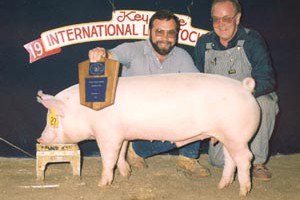
Dave Hosterman (left) and Vernon Hazlett (right), long time swine herdsmen at Penn State, with a show winner.
A report from the Agricultural Experiment Station in 1909 indicated that swine research was carried out by T. I. Mairs and S. W. Doty. It compared diets of "corn chop" and tankage with diets of middlings for pigs from a weight of 190 pounds to 635 pounds.
In 1927 the Agricultural Experiment Station reported on research done by M. F. Grimes in which he compared the use of various feed ingredients for growing and finishing swine. In 1936, M. A. McCarthy, T. E. Nichols and T. B. Keith carried out studies on the value of grinding corn for pigs.
The first Experiment Station Bulletin on swine research was published in 1940. This multi-year study concerning the protein levels for pigs of different weights was done by Keith and R.C. Miller, an Assistant Professor of Agricultural and Biological Chemistry. This was the most frequently cited swine research that has ever been published by Penn State. In the 1950s and 1960s, Penn State demonstrated the effects of crossbreeding on the reproductive traits of swine.
This effect of heterosis has given rise to the dominance of crossbreeding in commercial swine production. Penn State's early studies of swine behavior provided insight that led to improved swine management techniques. Early behavioral work concentrated on nursing behavior and the behavior of the nursing pig.
The first mention of a swine breeding herd was in 1920 when Grimes was in charge. In 1930 McCarthy was put in charge of the swine program. During his tenure, Penn State showed many barrows at the International Livestock Show. This effort produced a number of national champions in the Berkshire and Duroc breeds.
During McCarthy's tenure, Keith joined the faculty as an instructor and later was appointed an Assistant Professor of Animal Husbandry. Larry Gobble joined the faculty in 1947 and became head of the swine program. He taught courses in swine husbandry and nutrition and did research work in swine nutrition.
In 1949, the Pennsylvania Legislature passed the Livestock Improvement act. The act allocated funds to Penn State to improve the herds and flocks of the Department of Animal Husbandry. It established a revolving fund in which the monies could be spent for animals and the hiring of personnel since the proceeds of animal sales would be returned to the fund.
Grant Sherritt joined the faculty in 1949 as an instructor to do field research on strains of Landrace swine that had been developed by the United States Department of Agriculture. This work was carried out under a joint Penn State-USDA project. In 1951 Sherritt was given a research and teaching appointment that he held until he retired in 1985. In the mid-sixties, Sherritt was placed in charge of herds and facilities.
Vernon Hazlett was herdsman from 1959 to 1995 and was a major factor in the success of the swine breeding program. During this time, Penn State developed outstanding herds of Yorkshires, Berkshires, and Durocs and won many national championships at the International Livestock Show and the National Barrow Show. Such animals contributed significantly to the improvement of these breeds through sales of breeding stock to herds in Pennsylvania and other states.
The earliest reported swine facilities were located at Farm 5 near Houserville. The first permanent building there was a farrowing facility with 12 pens, reportedly built in the 1930s. All swine except sows and their nursing pigs were kept on pasture with movable structures for shelter. In the late 1930s, a similar building with 12 pens was built for feeding and nutrition trials. This building is now used by the Veterinary Science Department. A Quonset hut type of structure was built in the late 1940s to store feed, to house a grinder and a mixer, and to provide an office.
In 1950-51, hog cholera infected the swine herd, and all animals were slaughtered. For the next several years, pigs were purchased for classroom use and for feeding studies and then slaughtered at market weight. This provided the push required to develop plans for a new swine facility, and the present central facility was built in 1958. The "Agway Barn" was built in 1968 in order to evaluate a system of keeping pigs in the same pen from birth to market. Agway Cooperative financed the building and the research studies. A "Nebraska" open-front type of building was built in 1980, following a proposal developed by Sherritt and Dwight Younkin, Extension Swine Specialist, on staff from 1953 to 1980.
Feral Pigs
In the mid-1970s, nine weaning-age pigs were brought to Penn State from Ossabaw Island, Georgia. These were feral (wild) pigs whose ancestors had lived on the island for several hundred years. They matured at 200 to 300 pounds and at that stage had 3 to 4 inches of backfat. They were obese pigs and were used for about a ten-year period to study adipose tissue metabolism and factors that regulated adipose tissue growth and development.
Author: Grant W. Sherritt, Professor of Animal Science

